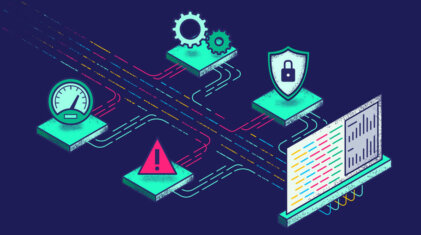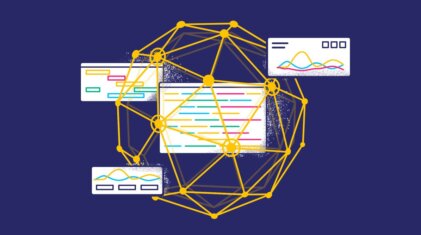Logging Best Practices: Knowing What to Log
What should we log? First of all, don’t ask this! Instead of asking what to log, we should start by asking “what questions do we want…
Whether you are just starting your observability journey or already are an expert, our courses will help advance your knowledge and practical skills.
Expert insight, best practices and information on everything related to Observability issues, trends and solutions.
Explore our guides on a broad range of observability related topics.

If you think log files are only necessary for satisfying audit and compliance requirements, or to help software engineers debug issues during development, you’re certainly not alone. With proactive log monitoring, you configure thresholds for key health metrics and trigger alerts when these are exceeded.
Although log files may not sound like the most engaging or valuable assets, for many organizations, they are an untapped reservoir of insights that can offer significant benefits to your business.
With the proper analysis tools and techniques, your log data can help you prevent failures in your systems, reduce resolution times, improve security, and deliver a better user experience.
Before we look at the benefits that log analysis can offer you, let’s take a moment to understand what logs actually are. Logs – or log entries – are messages that are generated automatically while the software is running.
That software could be an application, operating system, firewall, networking logic, or embedded program running on an IoT device, to name just a few. Logs are generated from every level of the software stack.
Each entry (or log line) provides a record of what was happening or the state of the system at a given moment in time. They can be triggered by a wide range of events, from everyday routine behavior, such as users logging in to workstations or requests made to servers, to error conditions and unexpected failures.
The precise format and content of a log entry varies, but will typically include a timestamp, log severity level, and message. Each log line is written to a log file and stored – sometimes for a few days or weeks (if the data is not required for regulatory reasons) and sometimes for months or even years.
Log analysis is the process of collating and normalizing log data to be parsed and processed for easier querying and providing visualizations of that data to identify patterns and anomalies.
Analyzing the data recorded in the log files from across your organization’s systems and applications will help you improve your offer’s services, enhance your security posture, and give you a better understanding of how your systems are used.
The primary use of log files is to provide visibility into how your software is behaving so that you can track down the cause of a problem. As computing trends towards more distributed systems, with applications made up of multiple services running on separate but connected machines, investigating the source of an issue has become more complex.
Collating and analyzing logs from the various components in a system makes it possible to join the dots and make sense of the events that led up to an error or failure. Automated log analysis speeds up this process by identifying patterns and anomalies to help you fix issues faster. Log data analysis can also be used to identify early warning signs that can alert you to similar problems earlier in the future.
The benefits of automated log analysis go further than troubleshooting issues that have already occurred. By analyzing log data in real-time, you can spot emerging issues before any real damage is done.
Observability solutions take these techniques a step further, using machine learning to maintain a constantly evolving picture of normal operations, with alerts triggered whenever anomalous behavior patterns are detected.
Taking a proactive approach to anomaly detection and troubleshooting can significantly reduce the number of serious and critical failures that occur in your production systems and reduce mean time to resolution (MTTR) for issues that arise. The result is a better experience for your users and fewer interruptions to business activities.
Observability and monitoring play an essential role in detecting early signs of an attack and containing threats. If a malicious actor does breach your defenses, log files often provide clues regarding how the attack was executed and the extent of the damage perpetrated or the data leaked.
Log data analysis expedites this process by drawing connections between activities, such as user account activity taking place out of hours coupled with unusual data access patterns or privilege escalation.
As well as providing the data required for reporting and audit compliance, this knowledge of how an attack was executed is essential for strengthening your defenses against similar threats in the future.
As users’ expectations of software systems continue to rise, maintaining high-performance levels, stability and uptime are essential. Analyzing log data from across your IT estate can help you build a fuller picture of how your systems are used, providing you with data to inform your decisions to make targeted enhancements.
By tracking resource usage over time, you can be proactive about provisioning additional infrastructure to increase capacity or decommissioning it to save costs. Identifying slow-running database queries so that you can optimize them improves not only page load time but also reduces the risk of locks or resource saturation slowing down the rest of your system.
Using log data to understand how users interact with your application or website can also provide valuable insights into user behavior, including popular features, common requests, referring sites, and conversion rates. This information is invaluable when deciding where to next invest your development efforts.
Log file analysis enables you to leverage the full benefits of your log data, transforming log files from a business cost required for regulatory reasons to a business asset that helps you streamline your operations and improve your services.

What should we log? First of all, don’t ask this! Instead of asking what to log, we should start by asking “what questions do we want…

The Internet of Things (or, IoT) is an umbrella term for multiple connected devices sharing real-time data, and IoT logging is an important part of this….

In this article, we are going to explore the process of ingesting and monitoring logs into your data lake, and the value of importing your firewall…

